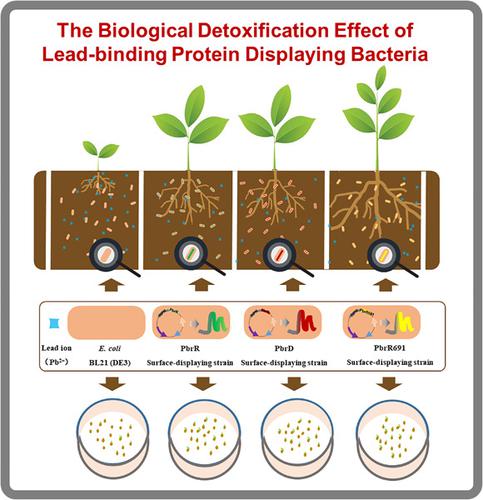当前位置:
X-MOL 学术
›
Biotechnol. Bioeng.
›
论文详情
Our official English website, www.x-mol.net, welcomes your
feedback! (Note: you will need to create a separate account there.)
Display of lead-binding proteins on Escherichia coli surface for lead bioremediation.
Biotechnology and Bioengineering ( IF 3.5 ) Pub Date : 2020-08-02 , DOI: 10.1002/bit.27525 Xiaoqiang Jia 1, 2, 3 , Ying Li 1 , Tao Xu 1 , Kang Wu 4
Biotechnology and Bioengineering ( IF 3.5 ) Pub Date : 2020-08-02 , DOI: 10.1002/bit.27525 Xiaoqiang Jia 1, 2, 3 , Ying Li 1 , Tao Xu 1 , Kang Wu 4
Affiliation

|
Cell surface display of heavy metal‐binding proteins has been used to enhance the adsorption capacity of heavy metals and the engineered microbial cells can be potentially used for the bioremediation of heavy metals. In this study, the proteins PbrR, PbrR691, and PbrD from the Cupriavidus metallidurans strain CH34 were displayed on the extracellular membrane of Escherichia coli BL21 cells, with the N‐domain of ice‐nucleation protein as the anchor protein to achieve specific adsorption of lead ions (Pb2+) and bioremediation of lead in the soil. The localization of fusion proteins was confirmed by western blot analysis. We investigated the effects of fusion pattern, expression level, heavy metal concentration, and the presence of other heavy metal ions on the adsorption of Pb2+ by these engineered bacteria, and the optimal linker peptide (flexible linker) and inducer concentration (0.5 mM) were obtained. The engineered bacteria showed specific selectivity and strong adsorption capacity for Pb2+. The maximum Pb2+ adsorption capacity of strains displaying the three proteins (PbrR, PbrR691, and PbrD) were 942.1‐, 754.3‐, and 864.8‐μmol/g cell dry weight, respectively, which was the highest reported to date. The engineered E. coli bacteria were also applied to Pb2+‐contaminated soil and the detoxification effects were observed via the seed germination test and the growth of Nicotiana benthamiana in comparison with the control BL21, which provides the proof‐of‐concept for in situ remediations of Pb2+‐contaminated water or soil.
中文翻译:

在大肠杆菌表面展示铅结合蛋白以进行铅生物修复。
重金属结合蛋白的细胞表面展示已被用于增强重金属的吸附能力,工程微生物细胞可潜在地用于重金属的生物修复。本研究将Cupriavidus metallidurans CH34的PbrR、PbrR691和PbrD蛋白展示在大肠杆菌BL21细胞的细胞外膜上,以冰核蛋白的N域作为锚蛋白,实现对铅的特异性吸附。离子(Pb 2+) 和土壤中铅的生物修复。通过蛋白质印迹分析证实了融合蛋白的定位。我们研究了融合模式、表达水平、重金属浓度和其他重金属离子的存在对这些工程菌吸附 Pb 2+的影响,以及最佳连接肽(柔性连接)和诱导剂浓度(0.5 mM) ) 获得。工程菌对Pb 2+表现出特异性选择性和强吸附能力。展示三种蛋白质(PbrR、PbrR691 和 PbrD)的菌株的最大 Pb 2+吸附能力分别为 942.1-、754.3-和 864.8-μmol/g 细胞干重,这是迄今为止报道的最高值。工程E .还将大肠杆菌应用于 Pb 2+污染土壤,通过种子发芽试验和本氏烟草的生长情况观察其解毒效果,并与对照 BL21 进行比较,为 Pb 原位修复提供了概念验证2+污染的水或土壤。
更新日期:2020-09-20
中文翻译:

在大肠杆菌表面展示铅结合蛋白以进行铅生物修复。
重金属结合蛋白的细胞表面展示已被用于增强重金属的吸附能力,工程微生物细胞可潜在地用于重金属的生物修复。本研究将Cupriavidus metallidurans CH34的PbrR、PbrR691和PbrD蛋白展示在大肠杆菌BL21细胞的细胞外膜上,以冰核蛋白的N域作为锚蛋白,实现对铅的特异性吸附。离子(Pb 2+) 和土壤中铅的生物修复。通过蛋白质印迹分析证实了融合蛋白的定位。我们研究了融合模式、表达水平、重金属浓度和其他重金属离子的存在对这些工程菌吸附 Pb 2+的影响,以及最佳连接肽(柔性连接)和诱导剂浓度(0.5 mM) ) 获得。工程菌对Pb 2+表现出特异性选择性和强吸附能力。展示三种蛋白质(PbrR、PbrR691 和 PbrD)的菌株的最大 Pb 2+吸附能力分别为 942.1-、754.3-和 864.8-μmol/g 细胞干重,这是迄今为止报道的最高值。工程E .还将大肠杆菌应用于 Pb 2+污染土壤,通过种子发芽试验和本氏烟草的生长情况观察其解毒效果,并与对照 BL21 进行比较,为 Pb 原位修复提供了概念验证2+污染的水或土壤。









































 京公网安备 11010802027423号
京公网安备 11010802027423号